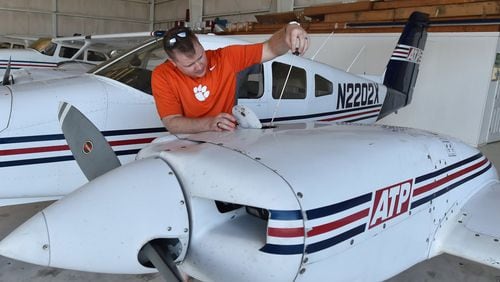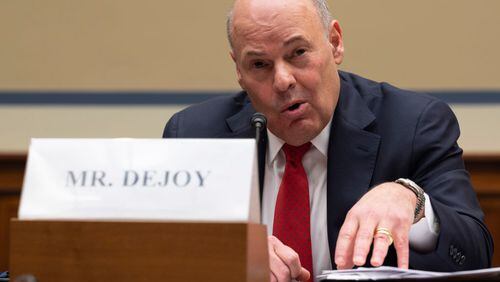A shortage of qualified pilots is causing growing concern at regional airlines that form a sort of farm system for major carriers.
Some small carriers such as Great Lakes Airlines have even canceled and cut flights, saying they could not find enough pilots. Memphis International Airport said a pilot staffing shortage contributed to Delta Connection flight cuts there, though Delta cited poor revenue as well.
To fill positions for entry-level pilots, regional carriers like SkyWest, Endeavor and Compass are offering signing bonuses of $5,000 or more, retention bonuses of up to $80,000 or tuition reimbursement.
That’s unprecedented in the industry and “indicative of the depth of the pilot shortage,” said Paul Templeton, regional jet program director at ATP flight school. “There’s a lot of opportunity happening in the chaos.”
Peachtree City-based pilot hiring expert Kit Darby said he has heard from qualified young pilots who applied for a pilot job at 2 a.m., “went to bed, and they were awakened at 6 in the morning by the airline.”
Driving such stories: Hiring by major carriers has rebounded sharply since a drop-off in 2009, from just 30 that year to 3,053 in 2014, according to pilot advisory site FAPA.aero. Many of the hires come from regionals, which then must scramble to fill slots.
The pipeline of new pilot candidates shrank during the recession, as reduced hiring at majors, the daunting cost of acquiring needed licenses and low initial pay discouraged some.
First-year pilot pay at many regional carriers has increased from a little over $20,000 last year to more than $30,000, according to Templeton.
But many new hires may have spent $100,000 on training and years as a low-paid flight instructor to accumulate the required flight hours for an airline pilot job, said Darby.
“You can’t raise a family on those wages,” Darby said. Some end up having to get second jobs, he said.
The long-term payoff remains attractive. Pilots who move up the ladder can see rapid pay increases, reaching the six-figure level within years and hitting more than $200,000 annually for senior pilots at the biggest airlines. A proposed new pilot contract at Atlanta-based Delta would pay captains of its biggest jets as much as an estimated $330,000 a year in 2018.
A thinned pipeline is not just an issue in the Unites States. Rapid growth in aviation in India and China, for example, is also creating high demand for pilots.
Meanwhile, older pilots are retiring in growing numbers. Six years ago, the U.S. government boosted the mandatory retirement age from 60 to 65, and those whose careers were lengthened are now leaving.
Delta is hiring some 800 pilots this year, but as a leading major carrier does not have the same problems as regional carriers in attracting applicants.
“We still continue to see a strong contingent of qualified applicants for our pilot ranks,” spokesman Michael Thomas said.
Delta is replacing many of its 50-seat regional jets operated by Atlanta-based ExpressJet and other regional airlines, shifting some flying by regional carriers to its own pilots.
Industry observers say the pilot market may get tighter before the cycle shifts again.
“At this point, the mainline carriers haven’t been impacted,” said Richard Wysong, director in the U.S. transportation and logistics consulting practice at PricewaterhouseCoopers, but “over time, the majors are going to be impacted, if nothing changes in the process.”
Dallas-based Southwest Airlines, the second-largest carrier in Atlanta, said it is not seeing pilot shortages, but “is keeping in mind that the military is reducing the number of trained pilots… [and] the expense of learning to fly continues to climb,” according to spokesman Dan Landson. The carrier is looking at offering more scholarships, attending more career fairs and meeting more students in high schools, he said.
Another change that plays into the issue: A 2013 Federal Aviation Administration rule increased the flight time required to become an airline pilot from 250 hours to 1,500 hours. The new regulation came in response to the 2009 crash of Colgan Air in Buffalo, N.Y. Pilot experience and training was determined to be a factor.
Beginning airline pilots often start at regional carriers like now-defunct Colgan, whose names are not well-known because they operate under banners such as United Express and Delta Connection.
Regional carriers are under intense pressure to hold down costs in order to win contracts with major airline partners. Pilots at some are unionized and paid under multiyear contracts. That all leaves regional operators with less flexibility to boost pay to draw pilot applicants.
Still, the Air Line Pilots Association, the world’s largest airline pilots union, says the root of the issue is pay.
Last year, the union told members of the U.S. House subcommittee on aviation that avoiding a pilot shortage “depends on whether U.S. airlines offer pilots competitive wages and benefits and a solid career — a market-based solution.”
Louis Smith, president of FAPA.aero, said airlines may eventually have to help finance pilot training — which he said could affect the cost of flying.
“If the airlines end up having to pay for people to learn to fly, they will add that to the price of a ticket,” Smith said. “Someone’s gotta pay for it.”







